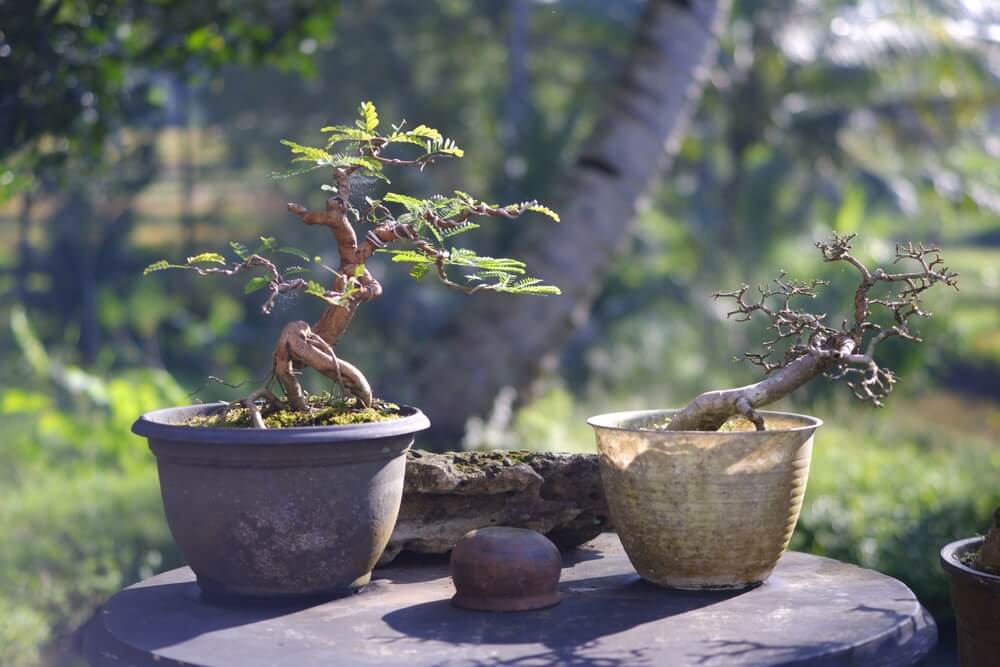How To Grow Gorgeous Bonsai Trees In Pots From Seed Or Nursery Stock!
Welcome! This article contains affiliate links, meaning I get a commission if you decide to make a purchase through my links, at no extra cost to you.
Curious about how to grow bonsai trees in containers or pots? This complete bonsai growing guide breaks down everything, including starting bonsai trees from seed, refining nursery stock into potted masterpieces, and long-term care. We’ll also discuss essential bonsai pruning techniques, styling secrets, and species recommendations to help you grow potted bonsai trees with confidence.
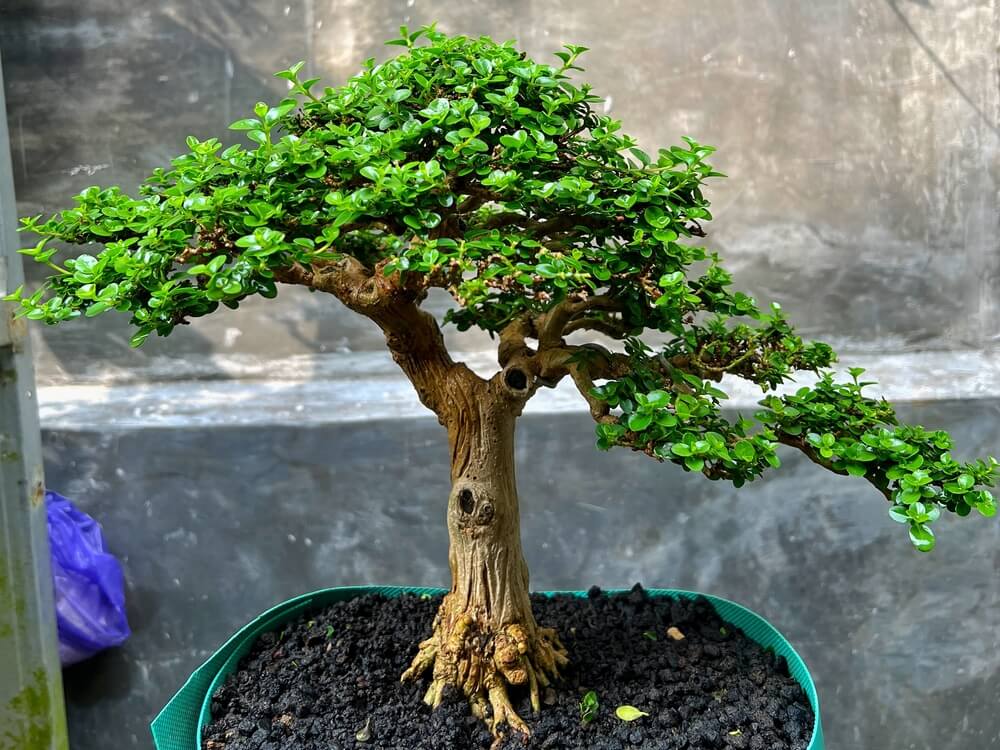
Sound fun?
Then let’s grow some epic potted bonsai trees!
Two Options For Growing Bonsai Trees – Nursery Stock Vs. Seeds!
Want to dive into the zen art of bonsai? You’ve got two paths ahead of you. And spoiler alert! One option is a many-year marathon. The other’s more like a brisk walk.
Growing Bonsai Trees From Seed
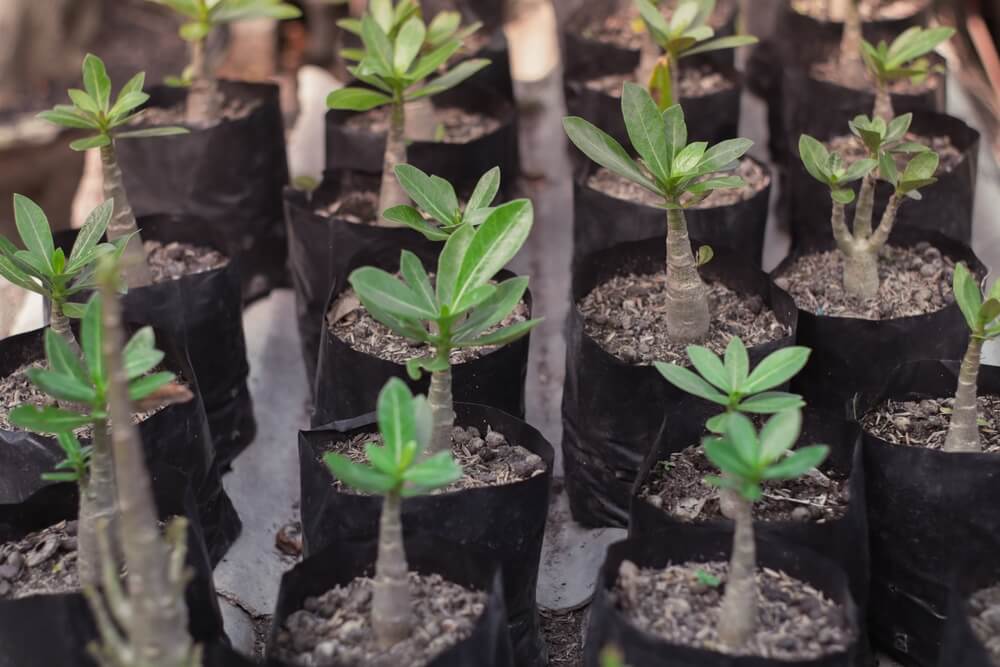
Growing bonsai trees from seed is easily the least expensive method. But it’s also the most difficult and time-consuming! Think of it as an indoor gardening hobby measured in seasons, not shortcuts.
Step 1. Choose Your Seeds With Precision
Select species that are naturally suited to bonsai cultivation, such as Japanese maple, black pine, juniper, or ficus. While it’s technically possible to train almost any tree into bonsai form, it’s wise to avoid random or ornamental seeds with poor structure, weak growth habits, or low aesthetic potential.
(We include an epic list of the seven best bonsai tree cultivars later in this guide. No worries!)
Step 2. Understand Stratification (And Respect It)
Many bonsai-capable tree seeds require stratification. It’s a cold dormancy period that mimics winter conditions. For species that need it, place the seeds in peat moss or moist sand and refrigerate them for 2 to 3 months. This step improves germination success and helps you avoid frustration later.
(Keep in mind that tropical species like ficus don’t require cold treatment. But most temperate species do.)
Step 3. Build A Proper Nursery Environment
Once germinated, bonsai tree seedlings require carefully managed conditions with consistent humidity, bright indirect light, and stable temperatures of roughly 65°F to 75°F. Treat them like VIPs. Young bonsai are delicate and require nurturing with discipline and care.
Step 4. Embrace The Long Game
Be warned. Growing bonsai from seed is a slow art. For most species, expect three to five years before meaningful styling can begin, and approximately ten years before your tree reaches maturity. The good news? What you’re growing is more than a plant. It’s a living expression of patience and vision.
Read More – 13 Fast-Growing And Affordable Privacy Trees That Fill Space Quickly!
Growing Bonsai Trees From Nursery Stock
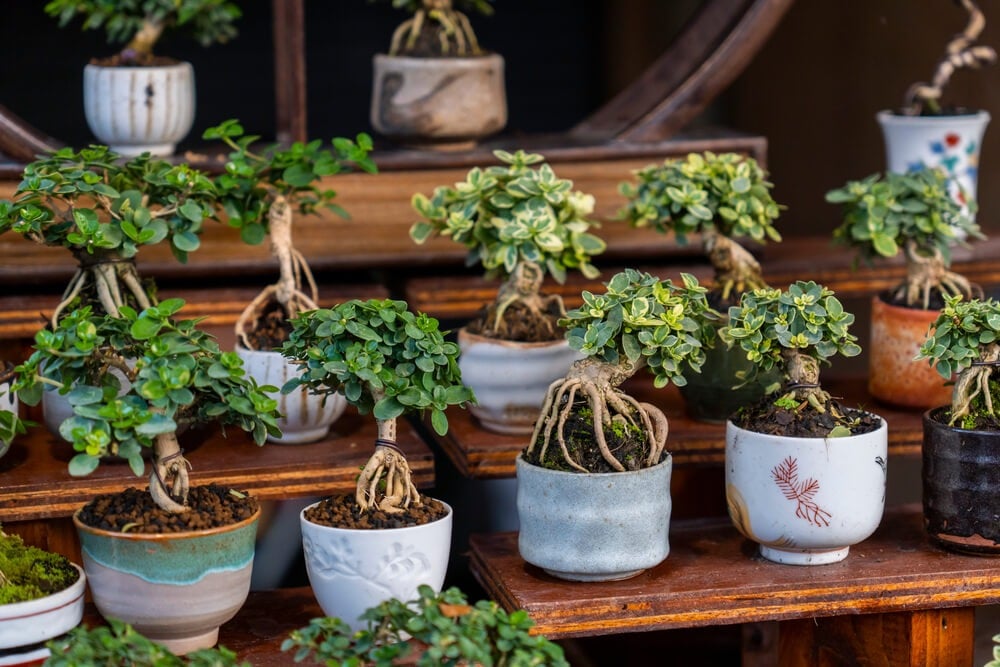
Growing bonsai trees from nursery stock is by far the most accessible method for beginners and serious hobbyists. While bonsai material can be expensive, this approach offers faster, more tangible results and eliminates much of the early guesswork. It’s ideal for those who want to cultivate beauty and structure within a realistic timeframe.
Step 1. Scout Like A Pro
Visit local plant nurseries, specialty growers, and even garden centers or big-box stores. Focus on young trees with interesting trunk movement, healthy root flare, strong lower branches, and signs of vigorous growth. Ignore generic “bonsai” tags and instead evaluate the raw material.
Step 2. The Great Repotting Adventure
Nursery stock is often root-bound and planted in poor soil. When the season is right (usually early spring before new growth begins), gently remove the tree from its plastic pot, trim away up to one-third of the root mass, and replant it in a well-draining bonsai substrate such as akadama, pumice, or perlite.
(We cover how to choose the perfect bonsai bowl in more detail momentarily.)
Step 3. Develop Your Green Thumb Routine
Refined bonsai growth depends on daily observation and seasonal rhythm. Water thoughtfully, fertilize monthly during the growing season, and prune with a vision. With proper care, your nursery stock can begin to resemble a legendary bonsai within one to two years.
Summary: Growing from seed is a lengthy and arduous process that demands patience and precision! Nursery stock, on the other hand, provides a more immediate and hands-on gateway into the world of bonsai artistry. Both paths lead to the same quiet reward – a living sculpture that grows with you, year after year.
Read More – Budget Zen Garden Ideas – Peace, Natural Landscape, And Meditation!
Bonsai Tree Growing Requirements
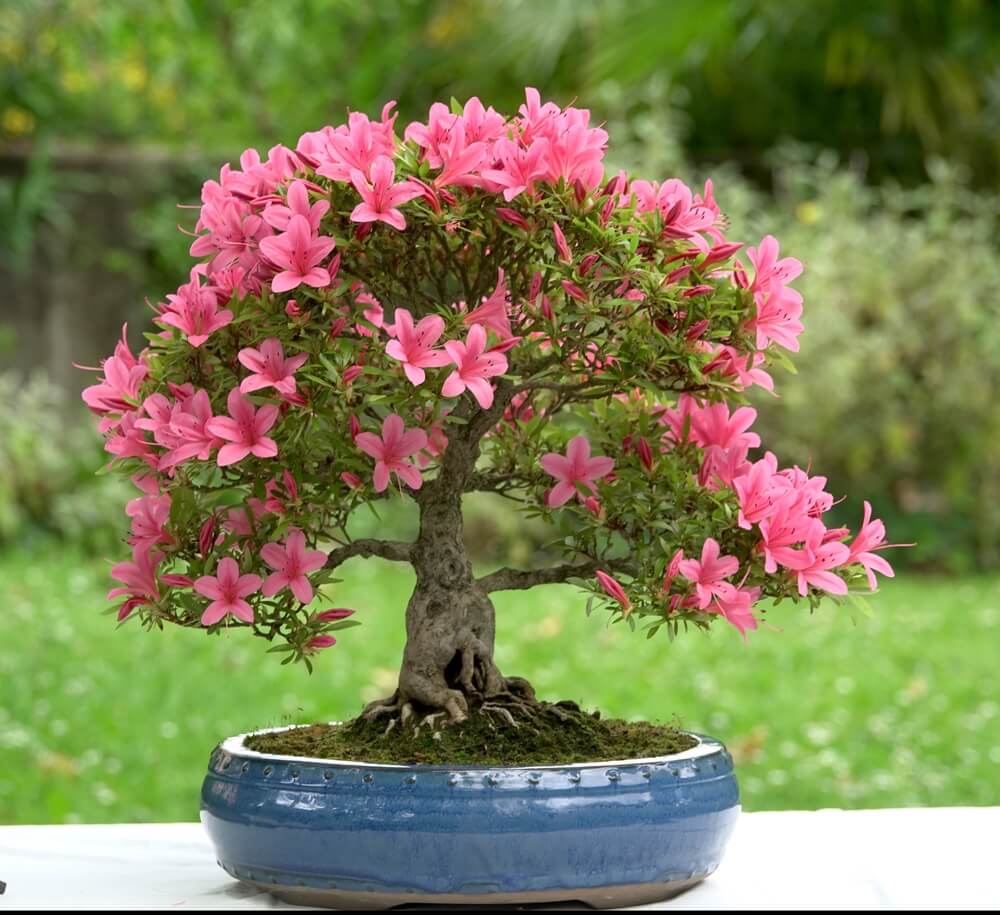
Growing bonsai isn’t rocket science, but it’s not set-it-and-forget-it either. Think of it as caring for a very particular pet who happens to be gorgeous and lives for many decades.
Sunlight
Most bonsai are drama queens when it comes to light. They want bright, indirect sunlight for 4 to 6 hours daily. Too little and they get leggy and weak. Too much direct scorching sun and they’ll crisp up like bacon. East or west-facing windows are your best bets for indoor growing.
Climate
Here’s the plot twist. Most “indoor bonsai” actually prefer to live outside! Tropical species (like ficus) can thrive in indoor environments, but temperate trees require a seasonal temperature swing to remain healthy. Opt for a temperature range of around 60 to 80°F, with good air circulation.
Soil + Fertilizer
Forget standard potting soil. It’s far too dense and moisture-retentive for bonsais. The result? Often suffocating your tree’s fine roots like quicksand. Instead, use a fast-draining, open-structured mix, typically composed of akadama, pumice, lava rock, or perlite, tailored to your tree species and climate.
During the growing season, feed with a diluted liquid fertilizer every 2 to 4 weeks. Go easy. Overfertilizing leads to coarse growth and ruins the refined scale that gives bonsai their miniature elegance.
Watering
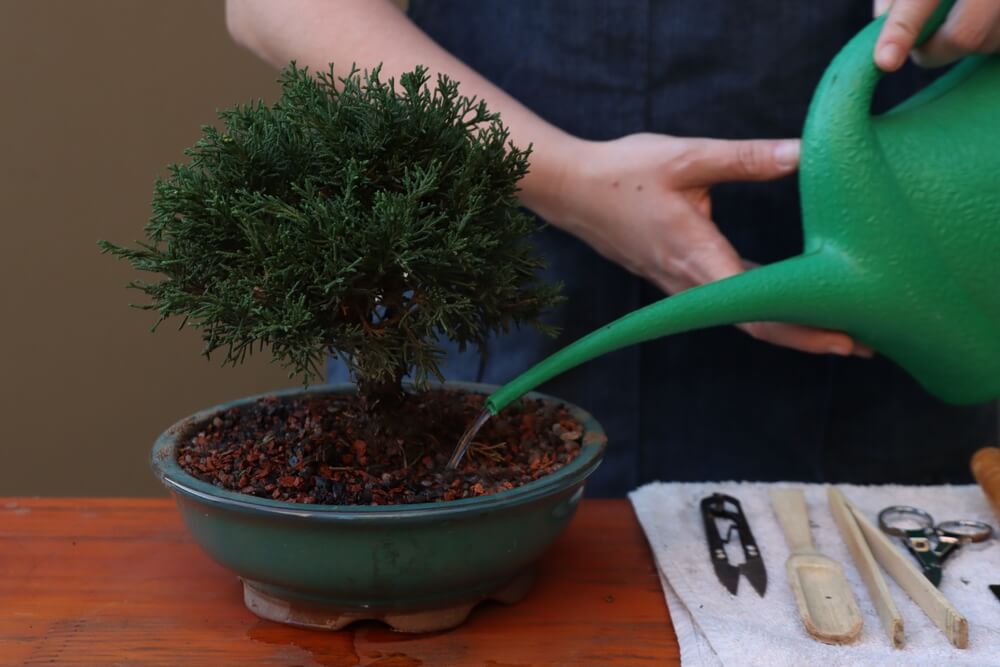
The golden rule for watering bonsais? Stick your finger in the bonsai’s container and feel the soil. Dry? Water thoroughly until your bonsai container is dripping from the drainage holes. If it feels moist, then wait another day and check again. Most bonsai deaths happen from overwatering, not neglect. Daily checks, but not daily watering!
Read More – 21 Gorgeous Trees With Purple Flowers, Leaves, Or Berries!
Choosing The Best Possible Pot For Your Bonsai Tree
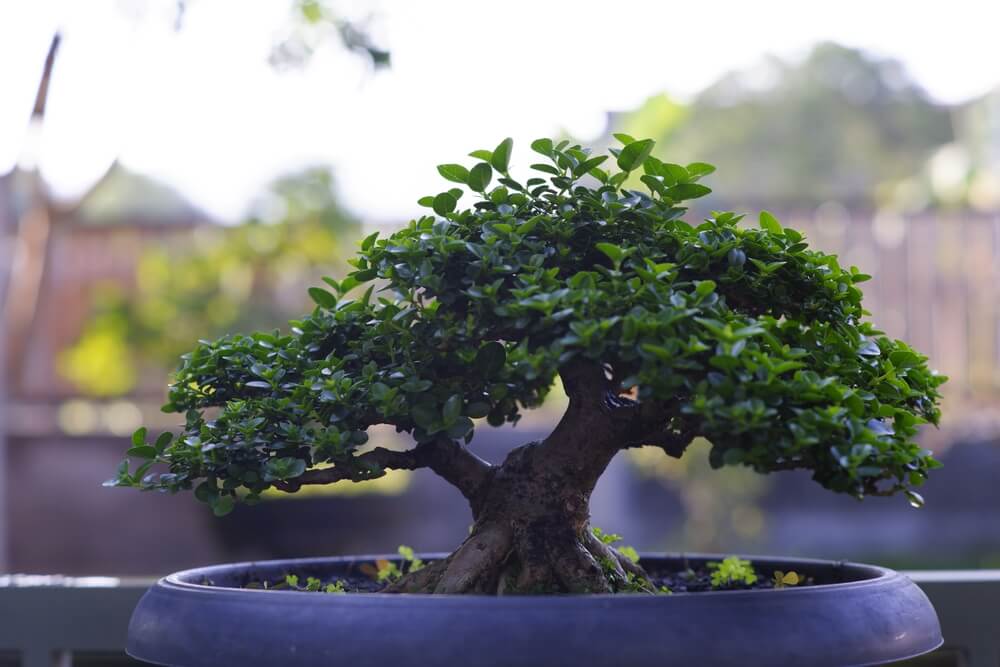
Your bonsai pot is far more than a container! It’s half the artistic equation that transforms your tree into an actual bonsai. Choosing the perfectly sized pot for your tree also helps ensure it remains the ideal size for your zen garden, patio, or backyard.
Start with a training pot that is slightly wider than the tree’s canopy and deep enough to support its roots. This size provides your bonsai tree with room to grow while maintaining proper proportions.
New trees from nursery stock often require larger “development pots” for the first 1 or 2 years to establish a strong root system before being moved to their final display container.
The pros follow basic proportion guidelines. As a general rule, the pot depth should match the thickness of the bonsai trunk at its base. The pot length is usually around two-thirds the height of the tree for upright styles, or the width of the canopy for wider or cascading styles.
Drainage is non-negotiable! Multiple holes are essential to prevent your bonsai tree’s cramped roots from suffering from waterlogging.
The Art of Bonsai Pruning – Where Magic Meets Method
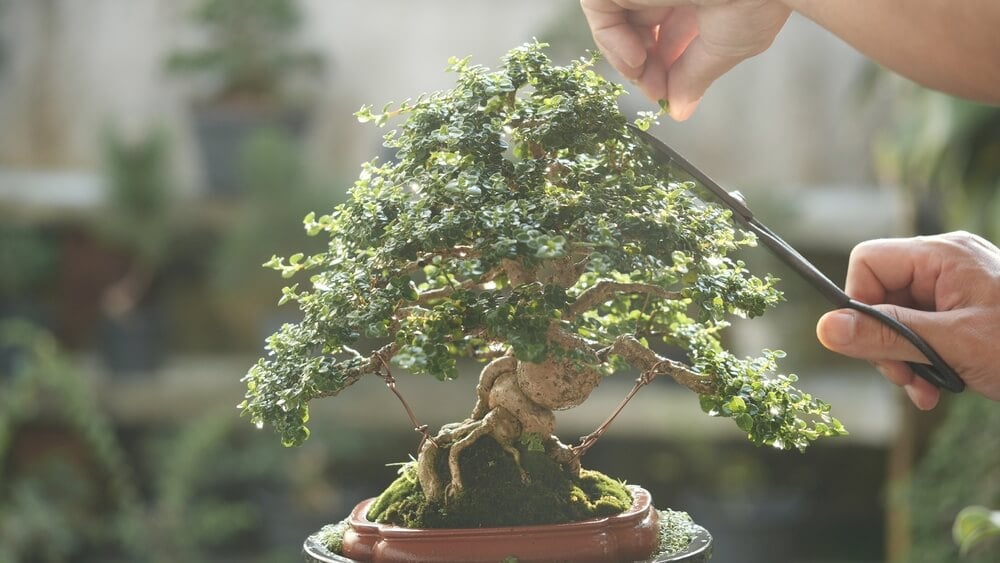
Here’s the biggest secret I’ve ever learned after growing bonsai trees for years. Pruning isn’t about cutting! It’s more about seeing the future tree hiding inside the current one.
The best pruners spend more time staring at their trees than actually snipping, visualizing how each cut will redirect energy and reshape the canopy in years to come.
Master the “one-third rule” first. Never snip more than one-third of a bonsai tree’s foliage at once, or you’ll shock it into survival mode instead of artistic growth. Start with the obvious stuff. Dead, diseased, or crossing branches that rub against each other.
Then, move on to structural pruning. Remove branches that grow straight up (they break the illusion of age), straight down (they appear unnatural), or directly toward the viewer (they flatten your design).
The real ninja technique? Learn to read your tree’s energy flow. Pinch strong branches back to redirect growth to weaker areas, creating a balanced, aged look that appears to have endured centuries of mountain winds.
Use your fingers for soft, new growth (for cleaner healing) and sharp, sterile tools for woody cuts. Always cut just above an outward-facing bud or branch junction. Cutting this way encourages growth in the desired direction while keeping the cuts invisible as the tree heals.
Timing is everything. Prune deciduous bonsai trees in late winter while they are dormant. Prune flowering bonsai trees immediately after their blooms fade to preserve next season’s buds. For evergreen bonsais, prune during the active growing season, but follow species-specific guidelines, especially for conifers like pines and junipers.
The pros know that strategic pruning is like conducting an orchestra. Every cut should have a purpose, whether it’s encouraging back-budding, maintaining proportions, or revealing that gorgeous trunk line you’ve been developing for years.
Bonsai Wire Training – The Art Of Gentle Persuasion
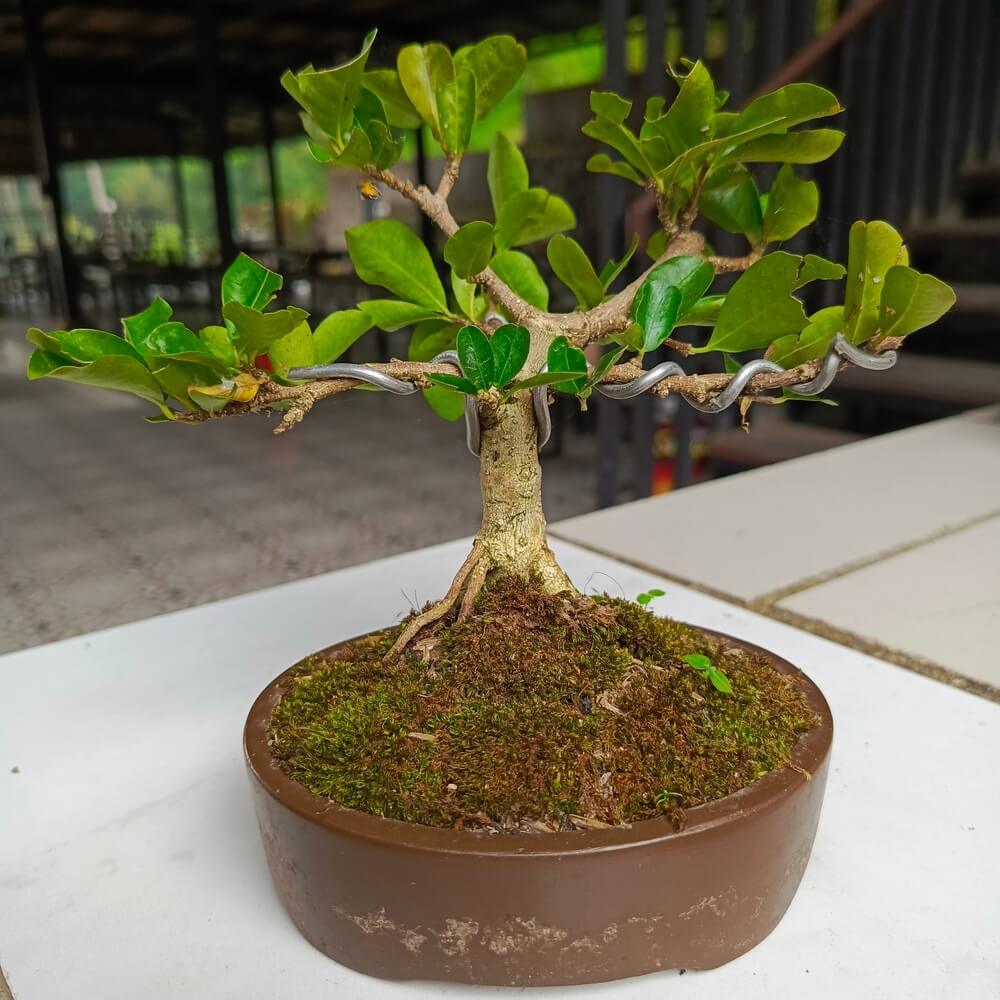
Wire training is an optional bonsai technique that involves wrapping wire around branches and trunks to gradually bend and shape them. Wire training gives you control over how your bonsai grows. It also allows you to create elegant, natural-looking forms that would take decades to occur in nature.
The goal is to create steady, directional pressure to mimic the natural effects of wind, snow, and age. Think of the wire as a temporary skeleton that slowly redirects growth into graceful, weathered shapes.
The wire gauge is critical. It’s usually one-third the thickness of the branch you want to bend. The wire should be snug enough to hold, but not so tight that it restricts growth. Start at the base and work outward. Wrap in the same direction you plan to bend. That way, the wire stays in place as the branch takes shape.
Aluminum wire is ideal for beginners and easy to remove. Copper wire is stronger and preferred by advanced growers, but it’s harder to work with. Professionals often wire entire sections at once to create natural, flowing lines instead of stiff, isolated bends.
Timing matters. Wire your deciduous bonsai trees during dormancy or early spring, when branches are bare and flexible. Always remove the bonsai wire before it cuts into the bark, usually after 3 to 6 months. Bend slowly and steadily. Rushing risks cracking the branch, while gradual pressure results in smooth, controlled curves.
Support the branch underneath as you bend. Younger wood adjusts faster. However, older wood retains its shape longer after wire removal.
Read More – Our Ultimate Nectarine Tree Growing Guide – Grow From Grafts Or Seed!
Bonsai Tree Care And Growing Schedule

Here are the critical dates all Bonsai tree growers should know.
April
April is your tree’s wake-up call! Start repotting deciduous trees (if needed) as the buds swell, but before the leaves emerge. Begin weekly fertilizing and move outdoor trees back to their sunny spots. Spring is prime time for major styling work.
May
Growth explosion month! Pinch soft new shoots on junipers to keep them compact and well-shaped. Start your watering vigilance. Trees are thirsty now. For pines, begin selecting strong candles if needed. It’s the perfect time to wire young branches while they’re still flexible and pliable.
June
June is summer prep mode. Increase watering frequency as temperatures rise. Trim back vigorous growth to maintain shape. Watch for pests. Aphids love this weather! Time to move heat-sensitive trees to partial shade.
July
High maintenance season! Daily water checks are non-negotiable now. Lightly prune deciduous growth if needed, but avoid major work. For two-flush pines, such as Japanese black pine, pinch the second candles now. Skip repotting. Trees are stressed enough from the heat.
August
Late summer styling window. Remove wires that are cutting into the bark from spring growth. Light pruning is okay, but save heavy work for fall. Keep up the daily watering routine. Dehydration kills faster than anything.
September
Prep for winter mode begins. Stop fertilizing nitrogen-heavy feeds. Start reducing watering frequency as growth slows. The perfect time for structural pruning and major wiring projects is before dormancy sets in.
October – March
Late fall and winter are the dormancy period. Deciduous trees drop their leaves, and growth slows or stops. Protect bonsai from frost and freezing winds. Some species, like tropical or subtropical bonsai, can be brought indoors near a bright window or under grow lights.
Cold-hardy trees, however, benefit from staying outdoors with shelter. Water less often, but never let the soil dry out completely. Avoid fertilizing or repotting. Use this time to plan, clean tools, and study your tree’s structure.
Read More – How To Grow Delicious Plum Trees In Your Backyard Garden Or Food Forest!
Best Bonsai Tree Cultivars
You can make a lovely bonsai out of any tree! But these 7 are our favorite bonsai trees for growing in containers. For sure!
Chinese Elm (Ulmus parvifolia)
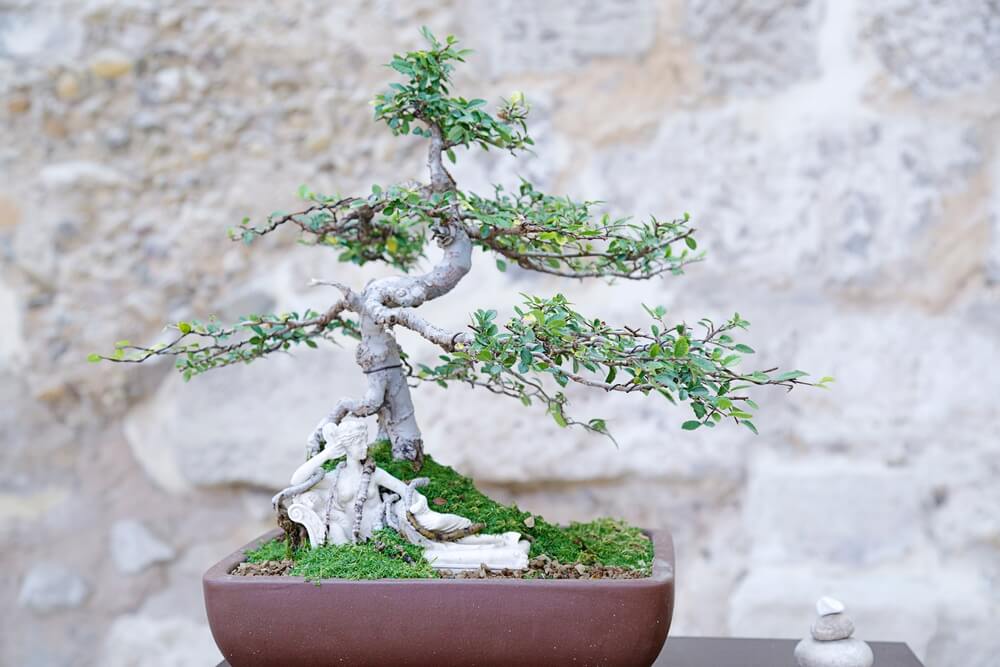
The ultimate beginner’s best friend! Chinese elms are practically indestructible and forgive almost every newbie mistake in the book. They develop gorgeous, gnarly bark texture and tiny leaves that look perfectly proportioned. Plus, they’re semi-evergreen, so you get year-round beauty without the drama.
- Size: 6 to 24 inches (bonsai), naturally grows 40 to 50 feet.
- Appearance: Small serrated leaves, exfoliating bark with orange/gray patches, graceful branching.
- USDA Growing Zones: 5 to 9.
- Bonsai Style: Informal upright, broom, windswept, cascade.
Chinese elm bonsai trees are like a wise old friend in miniature! They teach resilience and the quiet beauty of patience.
Ficus (Ficus retusa, Ficus benjamina)

The true indoor champions of the bonsai world. These tropical beauties can thrive under artificial lights and handle indoor heating systems like champs. They develop impressive aerial roots and glossy leaves, plus they bounce back from pruning faster than you can say “oops, cut too much.”
- Size: 6 to 36 inches (bonsai), naturally grows 6 to 10 feet indoors.
- Appearance: Glossy oval leaves, aerial roots, smooth gray bark, dense branching.
- USDA Growing Zones: 10 to 12 (indoor plant in colder zones).
- Bonsai Style: Informal upright, banyan, root-over-rock, multi-trunk.
The mighty ficus bonsai is a living testament to adaptability. These stout little fellows bend but never break. And looks fabulous doing it!
Japanese Maple (Acer palmatum)
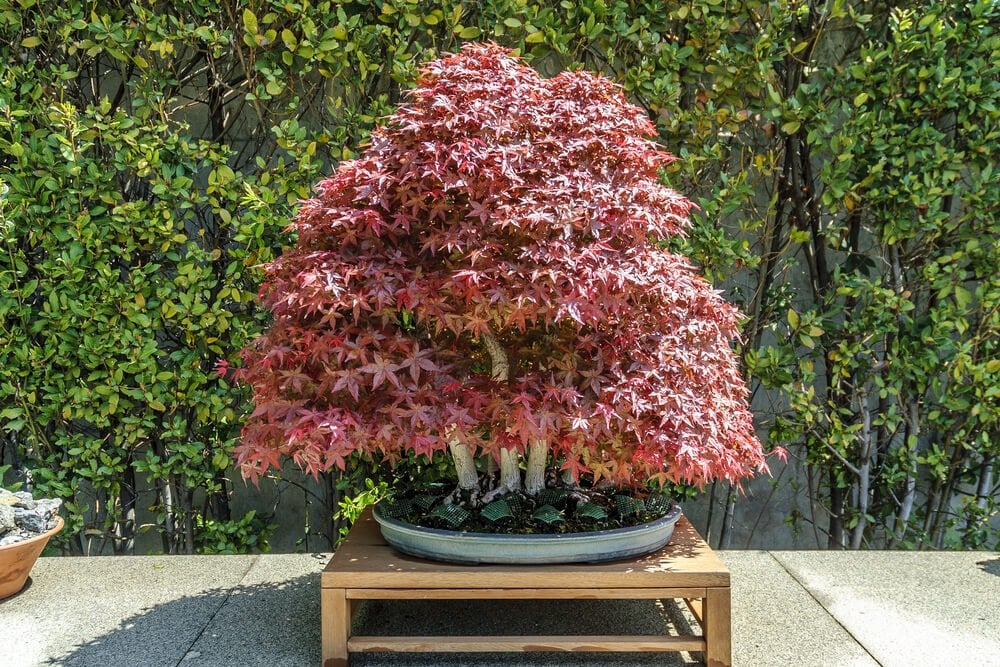
Pure seasonal poetry in a pot! These stunners give you spring greens, summer shade, and fall colors that’ll stop traffic. The delicate, palmate leaves and elegant branching structure make them living sculptures. Fair warning – they detest hot sun and dry conditions.
- Size: 8 to 30 inches (bonsai), naturally grows 15 to 25 feet.
- Appearance: Palmate leaves, seasonal color changes, delicate branching, smooth bark.
- USDA Growing Zones: 5 to 8.
- Bonsai Style: Informal upright, cascade, windswept, forest groupings.
Each Japanese maple leaf is a brushstroke in nature’s masterpiece, dancing through the seasons with hypnotic elegance.
Bougainvillea (Bougainvillea spp.)
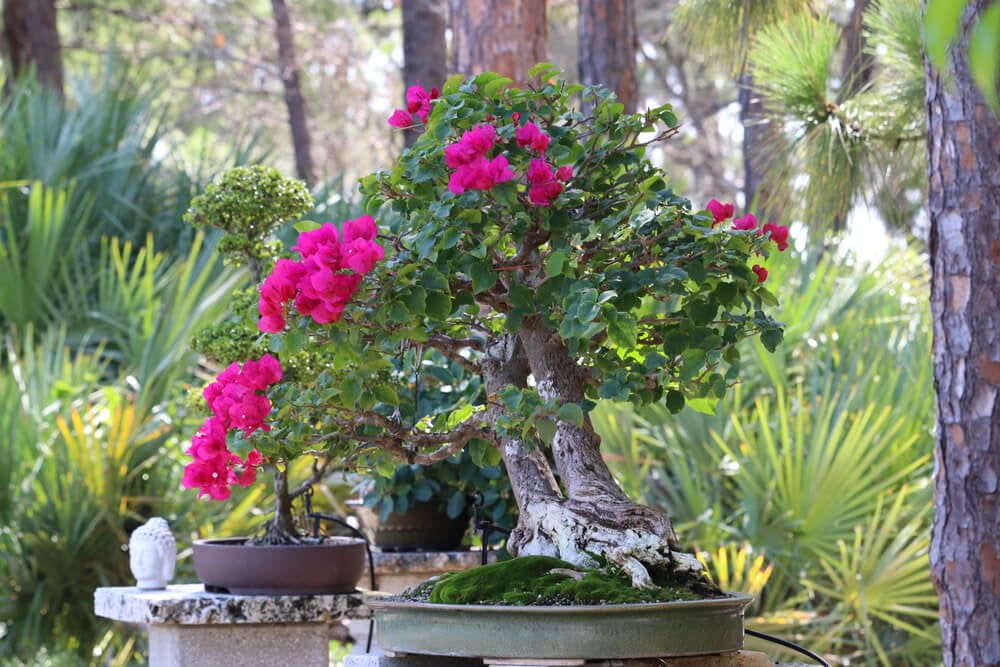
The showstoppers of the bonsai world with their explosive bursts of colorful bracts (those aren’t flowers!). They bloom repeatedly throughout the growing season and develop wonderfully gnarled, character-filled trunks.
- Size: 8 to 24 inches (bonsai), naturally grows 15 to 40 feet.
- Appearance: Colorful papery bracts, small green leaves, thorny branches, twisted trunk.
- USDA Growing Zones: 9 to 11.
- Bonsai Style: Informal upright, cascade, windswept, flowering display.
Bougainvillea bonsais prove that beauty and attitude go hand in hand. Just be cautious of those sneaky thorns during styling sessions!
Pine (especially Japanese Black Pine, Pinus spp.)
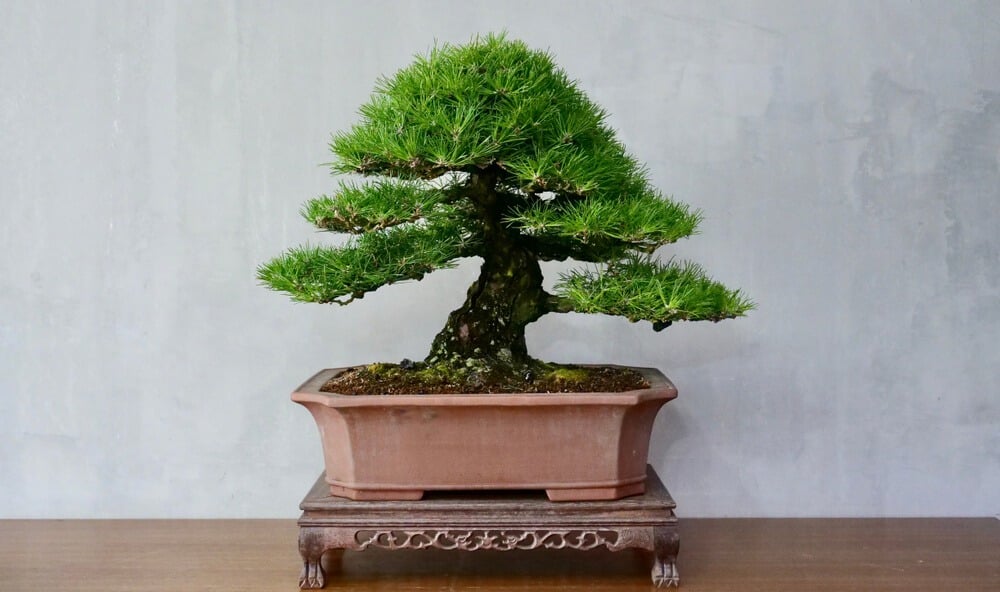
The classic masters of bonsai tradition. Japanese Black Pines develop that iconic windswept, ancient mountain look. They’re slow growers, which means your styling work lasts longer, and their needle-plucking techniques are pure zen therapy.
- Size: 10 to 36 inches (bonsai), naturally grows 20 to 60 feet.
- Appearance: Dark green needles, rugged bark, strong trunk taper, distinctive candles.
- USDA Growing Zones: 5 to 8 (roughly, depending on species.)
- Bonsai Style: Informal upright, windswept, literati, cascade.
Cultivating a pine is like shaping time itself. Slow, deliberate, and deeply meditative.
Juniper (Juniperus spp.)
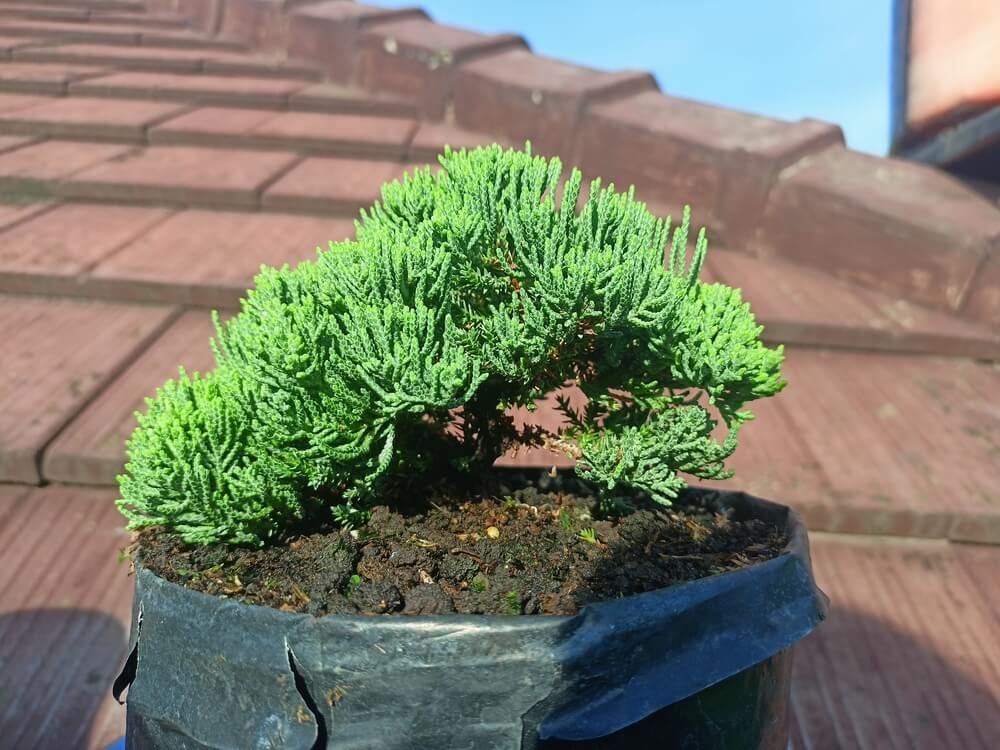
The rugged outdoor warriors who can handle almost any climate. These evergreens develop stunning, aged-looking bark and naturally compact foliage that responds beautifully to wiring and pruning.
- Size: 6 to 30 inches (bonsai), naturally grows 3 to 50 feet, depending on species.
- Appearance: Scale-like or needle foliage, fibrous bark, naturally compact growth.
- USDA Growing Zones: 3 to 9 (varies by species).
- Bonsai Style: All styles – informal upright, cascade, windswept, literati.
Juniper bonsai trees are perfect for creating dramatic cascades and windswept styles that look effortlessly wild.
Flowering Cherry (Prunus serrulata)
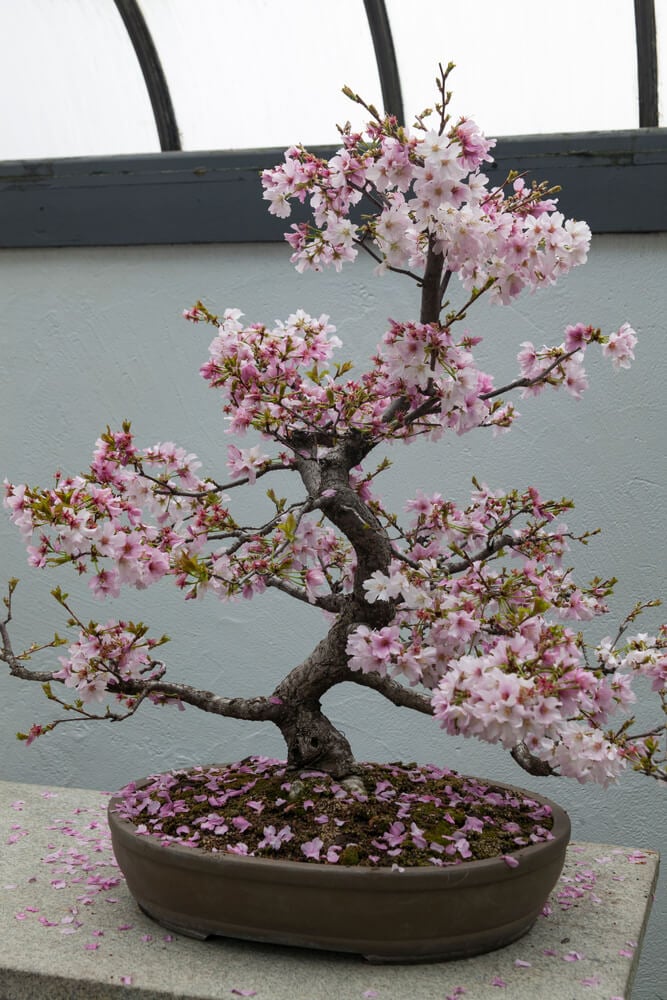
Spring’s most spectacular showoffs! When these babies bloom, they transform into clouds of delicate pink or white flowers that make everyone stop and stare. The trick is to enjoy the brief but breathtaking flowering season, then appreciate their elegant branching structure and beautiful bark for the rest of the year.
- Size: 10 to 24 inches (bonsai), naturally grows 20 to 25 feet.
- Appearance: Spring flowers (pink/white), serrated leaves, smooth bark with horizontal lines.
- USDA Growing Zones: 5 to 8.
- Bonsai Style: Informal upright, cascade, flowering display, forest groupings.
Cherry blossoms are arguably the most bedazzling of all bonsai cultivars. It’s like a poem that writes itself each spring.
Read More – 14 Beautiful Dwarf Conifer Trees Perfect For Tiny Rock Gardens, Small Spaces, Or Lovely Winter Decor!
Common Bonsai Growing Problems
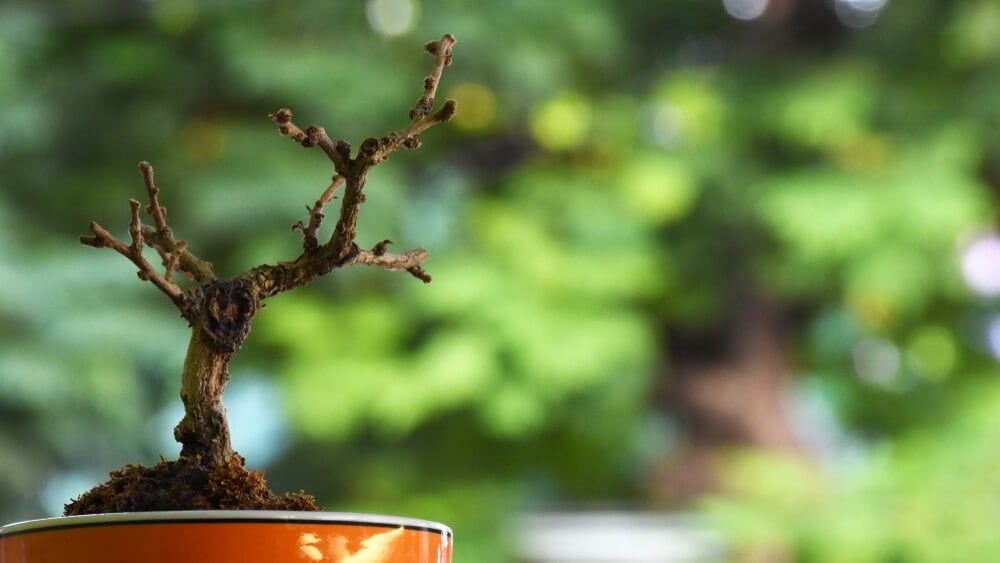
Growing bonsai trees is surprisingly easy. However, there are a few issues to be aware of.
Watering Issues (Overwatering Or Underwatering)
The classic bonsai killer that gets 90% of beginners! Overwatering creates soggy roots that rot faster than backyard compost, while underwatering turns your beautiful tree into expensive kindling.
The telltale signs are yellow, dropping leaves (usually due to overwatering) or crispy, curled leaves (indicating underwatering). Pro tip: Stick your finger in the soil daily. If it’s still moist an inch down, skip the watering can.
Pests And Diseases
Nothing ruins your zen like discovering tiny aphids throwing a party on your prized juniper! Scale insects, spider mites, and fungal infections love stressed bonsai trees. Watch for sticky honeydew, tiny webs, or suspicious spots on leaves.
The good news? You can typically resolve most pest problems by ensuring proper air circulation, adequate watering, and applying occasional insecticidal soap sprays. Prevention beats panic every time.
Improper Pruning Or Training Mistakes
We’ve all been there. One snip too many and suddenly your carefully planned design looks like a bad haircut! Common disasters include cutting the leader (oops, there goes your height), over-wiring that leaves permanent scars, or pruning at the wrong time of year.
The brutal truth? Most styling mistakes take years to fix, but trees are surprisingly forgiving. When in doubt, step away from the scissors and sleep on it.
Read More – 21 Fast-Growing Shrubs And Trees For Sustainable Firewood!
Conclusion

You now have everything you need to start growing bonsai trees in containers like a pro! Remember, every bonsai master started exactly where you are right now, probably killing a few trees along the way (it’s practically a rite of passage). So grab your favorite species and get ready for a decades-long hobby that doubles as a living art form. Your future tiny forest awaits!
What about you?
- Would you like to try growing a potted bonsai tree?
- Which bonsai species will you grow?
- Will you grow them indoors? Or let them enjoy some sunny weather too?
Thanks for reading.
Have a great day!

